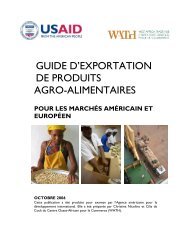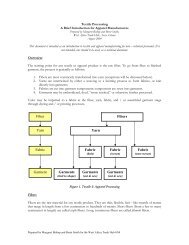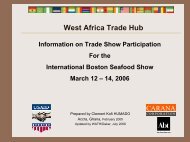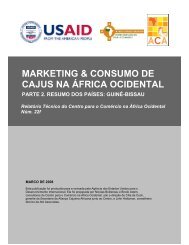Shea Butter A Guide to Production and Marketing - AGOA Export ...
Shea Butter A Guide to Production and Marketing - AGOA Export ...
Shea Butter A Guide to Production and Marketing - AGOA Export ...
You also want an ePaper? Increase the reach of your titles
YUMPU automatically turns print PDFs into web optimized ePapers that Google loves.
Peace Corps Ghana Version 1, March 2008<br />
uses include cosmetics <strong>and</strong> pharmaceuticals. The export market for CBRs is shared by<br />
Unilever (UK), Arhus (Denmark), Fuji I<strong>to</strong>h <strong>and</strong> Kaneka-Mitsubishi (Japan).<br />
3: The <strong>Shea</strong> Market<br />
The <strong>Shea</strong> Market: Local <strong>and</strong> International<br />
The local <strong>and</strong> international shea markets are two very different buyers with the<br />
international market having strict specifications while the local market uses shea<br />
butter for its traditional uses. These two markets are beginning <strong>to</strong> conflict with each<br />
other as dem<strong>and</strong> forshea butter increases on the international market. As the<br />
international market dem<strong>and</strong> increases, the price of nuts <strong>and</strong> butter in the local market<br />
increases at the same time. The high dem<strong>and</strong>s have made local shea butter <strong>and</strong> nuts<br />
less affordable on the local market creating an interesting situation for local<br />
consumers <strong>and</strong> producers.<br />
The Local Market:<br />
The local shea market exists because of the women of Ghana. There are men who<br />
trade in nuts <strong>and</strong> work in processing but women are the primary pickers, processors<br />
<strong>and</strong> sellers of shea butter in the local marketplace. The majority of shea butter<br />
consumption in Ghana is in the raw form for cooking <strong>and</strong> skin care. Some local shea<br />
butter is processed <strong>to</strong> make soaps that are sold in the market as well. The processors<br />
sell directly <strong>to</strong> the end consumer in the local market. Very little is packaged, labeled<br />
or certified before sale <strong>and</strong> it is sold in small balls or bowls in major markets<br />
throughout the country (Northern regions?).<br />
The International Market:<br />
The world’s biggest international markets for shea butter are in Europe <strong>and</strong> North<br />
America. <strong>Shea</strong> is used primarily for skin care cosmetics <strong>and</strong> for medicinal <strong>and</strong><br />
cooking products. The industry is extremely competitive <strong>and</strong> is dominated by about<br />
six large international companies (see section 7). Supply <strong>to</strong> the major companies on<br />
the international market is typically done by another organization within Ghana that<br />
buys nuts <strong>and</strong> processes butter <strong>to</strong> the specifications of the major buyer. These<br />
contracts are very big <strong>and</strong> have extremely strict quality requirements. Communities<br />
in Ghana generally supply the nuts <strong>to</strong> local buyers who in turn supply the international<br />
companies with bulked shea nuts or butter. There are also certain organizations<br />
buying shea butter from individual communities but st<strong>and</strong>ard quality is a challenge.<br />
Increasingly due <strong>to</strong> corporate responsability, certain companies like Savannah Fruits<br />
Company, although relatively small, have been working <strong>to</strong> attain quality commercial<br />
production while supporting rural women’s groups.<br />
Page 10 of 28









